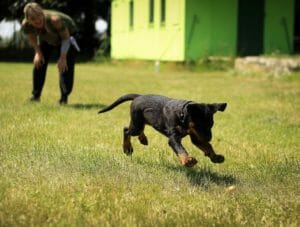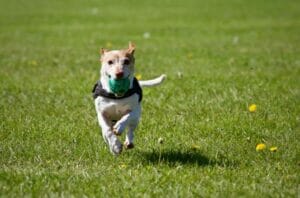What if there was a way to improve your pet’s physical and mental well-being… and it was free! Well, there is, and it’s called ‘exercise’. From the diminutive Chihuahua to the towering Great Dane, all dogs need exercise… but not the same amount. Which raises the question of how much exercise does a dog need?
How much exercise does a dog need?
Who can run the greater distance: You or your neighbor? It would be extraordinary if you both ran exactly the same distance. Instead, factors such as age, fitness, nutrition, and health, impact your endurance and ability to exercise. The same is true for dogs, plus there’s an additional factor in their ‘breed’. When deciding how much exercise does a dog need, study your canine as an individual. Your best buddy’s needs depend on:
- Age
- Fitness
- Health
- Body condition
- Breed
- Weather conditions
Monitor your DOG’s health 24/7
How to Exercise a Dog: Myth Busting
My dog gets plenty of exercise because he has free access to the yard. Right? Wrong! Dogs tend to wander around a yard. Yes, they stretch their muscles, but no they aren’t burning many calories or improving cardiovascular fitness. Think of this as the difference between walking around a superstore and going on a jog. Shopping doesn’t keep you slim, whereas running can. Exercise should be active and involve getting slightly out of breath and raising the heart rate.
How to Exercise a Dog: 5 Golden Rules
It’s impossible to put a flat figure on how much exercise a dog needs, as each dog is different. There are, however, five golden rules on how to exercise a dog.
- #1: You went too far if the dog is too tired to walk home without lagging behind
- #2: You’re aiming for the amount of exercise that leaves the dog ‘pleasantly tired’
- #3: Walk the dog to warm them up, before engaging in energetic activities such as Fetch
- #4: Protect a puppy’s joints by avoiding concussive activities (such as agility)
- #5: Don’t overtire growing dogs (it risks damaging their joints)
Age and How to Exercise a Dog
Different life stages need to exercise in different ways. Take puppies as an example. These guys are sprinters. They have short bursts of frenetic play, then crash on the spot and sleep. Puppies also have slack ligaments and soft bones. This means it’s vital not to overtire them. Moving awkwardly can damage a developing joint. For puppies under about 10 -12 weeks of age, play is the only exercise they need. Taking part in Canicross is grown-up stuff. Speaking of which, save boisterous activities such as agility, until the dog has finished growing at around 12 – 18 months (depending on breed!) Also, older dogs need steady walks. Keep to a similar distance every day, since they don’t have the muscular or joint strength to cope with a once-a-week long walk at the weekend.

Breed Matters
How much exercise do dogs need? Different types of dogs have different needs. Take a typical terrier. A Jack Russell’s distant ancestors were working dogs, bred to hunt all day without tiring. Contrast this with a Pekinese. These guys were bred to be consummate cushion lovers and prefer people power (i.e. being carried) to walking any great distance. When wondering how to exercise a dog, use their genetic makeup to guide you. Research the type of dog to see how much exercise they generally require. You can then use this as a rule of thumb, and then make allowances for the dog’s health and fitness levels.
The Difference Between Fitness and Health
A dog can have good health but not be fit. There’s a difference. A fit dog has a firm muscle tone, strong lungs, and good circulation. They are able to run and play with enthusiasm. Conversely, a dog may be ‘well’ in that they aren’t sick, but is unfit and gets out of breath walking uphill. This is an important difference. An unfit dog needs to slowly build up their muscles and fitness. So if you rescue an adult Jack Russell that’s been in a shelter for months, don’t go for a 10 km hike the first weekend home. Gradually build up their endurance with slowly increasing distances. Also under health comes ‘body condition’. This is code for how thin or fat the dog is. If your dog has too many ‘layers of love’, then slowly increase their exercise, under veterinary supervision, so the dog doesn’t damage their joints.
Not Enough…or Too Much Exercise: The Tell-Tale Signs
Learn how to read your dog and tell when they’re too tired (or indeed, bored through lack of exercise). PetPace can help with this. After exercise, a pleasantly tired dog settles down for a relaxed snooze. Whilst you’re at work, via the PetPace app you can access the dog’s vital signs and find out whether they’re lying, sitting, or standing. If the dog is heavily asleep, you can be reassured the morning walk was sufficient.

Likewise, PetPace is a great tool for building fitness levels. It tracks heart and respiratory rates. Importantly, it sends you an alert if the pet’s heart rate is unusually high. This is an invaluable guide as to how much exercise is too much for that individual. PetPace Smart Sensing Collar also tracks calories burned per day. From building up fitness to dieting a dog, this helps you meet targets and, where appropriate, gradually extend them.
Need help setting fitness goals and tracking your pet’s health on your PetPace app? Contact us here.

